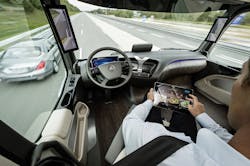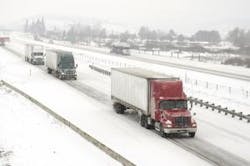The self-driving truck: The human factor
Time waits for no man. But technology must—especially when it’s poised to deliver radical change to an entire industry. To be sure, self-driving truck technology will only move forward as fast as fleet owners and other trucking stakeholders welcome it. And that will take time.
The adoption of self-driving trucks might well advance rapidly once fleets—and their drivers—can experience them first-hand. On the other hand, the truck makers, component suppliers and subsystem providers already developing this technology ultimately will require the buy-in of fleet owners, trucking lobbyists and safety advocates for self-driving trucks to get rolling in a big way.
The route to that happening will be gradual. It appears the first widespread deployment of the technology in the U.S. will be the wireless “platooning” of tractor-trailers, both to cut fuel consumption and heighten highway safety. From there, it will take the recognition of the technology’s benefits by fleets, shippers, regulators and the public before truly autonomous trucks—still piloted by truck drivers onboard to take over when manual control is required or emergencies arise—will appear on our highways in appreciable numbers.
To get a sense of how self-driving truck technology is being perceived at this early stage, we queried a diverse group of trucking experts (fleet executives, trucking lobbyists, researchers and consultants) on how operating fully self-driving trucks might affect a truck driver’s performance (especially regarding safety, fuel-efficiency and productivity), on-duty responsibilities and job satisfaction as well as how adopting autonomous vehicles could change the ways fleets recruit and retain truck drivers.
While no response evinced an outright Luddite rejection of self-driving trucks, individual replies ranged from those embracing the projected benefits, to those reflecting doubts about the practical feasibility, to those expressing skepticism about the predicted impact, to those suggesting that it’s just too soon to draw meaningful conclusions about self-driving trucks.
Sanford Hodes, Ryder’s senior vice president of safety, health and security, considers it premature to speculate about potential impacts to highway safety, vehicle performance and driver recruitment given that it is “so early in the study and design” of self-driving truck technology.
Eyes Wide Open
But he also points out that Ryder does “support the work being done to investigate the viability, efficacy and safety of this technology and will continue to watch its development with interest.”
“Penske Logistics is acutely aware of the technological advances in the operations of trucks,” states Tom Scollard, vice president of dedicated contract carriage. “Our company has been integrating technologies like collision avoidance and blind-spot warning notifications into our fleets. We also utilize onboard technology that monitors miles-per-gallon efficiencies, idle time and [driver] behaviors like hard braking.”
He says such technological advances have “created a safer environment for motorists and within our industry. Our drivers certainly enjoy the amenities that come with late-model trucks, and it has made their jobs easier and the profession itself more attractive as a result. We regard technological advances as new tools for our drivers, who continue to work hard for our customers.
“We feel that the concept of true self-driving trucks is years away from becoming a reality, and at best [will be used] in a linehaul application,” Scollard continues. “Our core business is delivery-intensive, requiring extensive driver involvement of value-add service, at either the point of delivery or the point of pickup.”
Firmly in the far-from-impressed camp is Lana Batts, co-president of driver-screening firm Driver iQ and a former president of the Truckload Carriers Assn. “Ain’t never going to happen,” she states flatly. “The so-called ‘safety Nazis’ will kill it before it ever gets tested. They dislike drivers, but they dislike driverless trucks even more.”
As for how the technology will impact truck drivers, Batts “thinks they will get bored and even more accidents will happen.” She points out that along a 500-plus mile stretch of straight railroad track in Australia, “they had to install a switch that the train operator had to push every few minutes because [locomotive operators] were falling asleep.”
Offering a skeptical take is Norita Taylor, spokesperson for the Owner-Operator Independent Drivers Assn. (OOIDA). She remarks that it seems self-driving truck technology “could only be used where it would have the least impact on safety.”
According to Taylor, OOIDA doesn’t see self-driving trucks bettering highway safety. “How would interference from other vehicles, such as passenger vehicles, be controlled, especially in platoon situations…When moving through traffic lights, how will trucks ‘know’ a light has changed, again, especially with platoons, if the first truck goes through and the light changes before the other driverless trucks go?”
What about cars?
She also asks, “How would you address factors that affect the technology and cannot be controlled, such as weather or electrical storms, ice, blizzards, and tunnels where GPS is compromised? Who would control the systems that control the trucks—individual fleets? How would conflicts between systems be addressed where multiple trucks interact, like in a shipping yard? And what about hacking?”
In terms of “pure speculation,” Bob Costello, chief economist and senior vice president of the American Trucking Assns. (ATA), says that “if the technology is more reliable, by taking humans out of the equation, it should be safer. However, are four-wheel vehicles going to have the same technology? The vast majority of car-truck crashes are the fault of car drivers. If they are still driving [without this technology], safety may be slow to improve from this.”
“Do I think safety numbers would improve as a result of self-driving trucks?” says David Heller, director of safety and policy for the Truckload Carriers Assn. (TCA). “Sure, but that is only under the assumption that self-driving passenger vehicles become the norm as well. I think we, as an industry, know that many a cause of accidents is not the result of our drivers. To say that this technology is a boon to highway safety would mean that the technology eliminates other drivers, weather and any other outside influence that may prove to be an accident cause as well.”
He also contends that “as technology changes, so do job expectations and performance standards. Even in today’s truck, a driver does so much more than just having his or her hands on the wheel. So, I’m certain that any new technology that eases the behind-the-wheel pressure will almost certainly put forth pressure elsewhere on the driver to make up for that.”
On the other hand, Heller figures that “fuel efficiency is one area that certainly can benefit from self-driving trucks. Acceleration and braking will most likely be programmed to optimum levels, causing the trucks to perform at maximum fuel-efficient standards.”
Paul Menig, CEO of consultancy Tech-I-M and a former Daimler Trucks engineer, is “certain this will help some aspects of safety. It’s so easy to be distracted in traffic and have a ‘rear-ender.’ That’s why fleets have wanted the radar systems in the trucks to work with braking all the way down to 0 mph, rather than only at cruise speeds.”
He adds that self-driving technology could also cut accident costs by reducing low-speed rollovers as well as damage incurred by trailers from improperly backing into docks, noting that “both ZF and Volvo have demonstrated how computers with cameras and sensors can do a better job of backing up a vehicle than a human.”
Wider appeal
Menig does caution that given that “more automation has been shown to cause airline pilots to lose some knowledge, experience and skills in critical situations,” the driving skills of the truck driver will have to remain paramount.
“Piloting a truck, especially one hauling hazardous cargo or a long combination vehicle, is likely to still require a driver to be available to take over in case of an emergency,” he continues. “But then the truck’s automation system could require that a driver go through an annual assessment” to ensure that they remain highly skilled whenever they’re at the wheel.
TCA’s Heller argues that “drivers are people and a self-driving truck should never take away from that fact or a carrier will continue to have a retention problem.”
He adds that he is “not sold that the technology will require a less proficient driver, but rather a driver with different proficiencies and the market will determine what value will be placed on those proficiencies.”
Ellen Voie, president & CEO of the nonprofit Women In Trucking Inc. and formerly manager of recruitment and retention for Schneider, expects self-driving technology will “make the career more attractive, especially to the next generation of potential drivers. The job would be safer, since the human error factor is greatly reduced, and in regard to productivity, the carrier can get more work done by a driver who has time to do other tasks when on the road.
“Greater use of technology usually requires a higher level of skill to operate, so I would hope that [self-driving trucks] would lead to higher driver pay,” she continues.
“I would suspect the drivers will also be expected to multi-task in ways by which the carrier could benefit, so increasing the productivity of the operator should boost their pay,” Voie remarks. “A carrier could potentially put a dispatcher or recruiter or even a bookkeeper in the truck—who could then function as a driver and office employee at the same time.”
Work no issue
Daniel Murray, vice president of research for the American Transportation Research Institute (ATRI), contends that “requiring less work of truck drivers is not really an issue for either safety or driver recruitment.”
According to Murray, fatigue registers as a critical factor in less than 8% of truck-involved fatalities. What’s more, he contends that “drivers today enter trucking knowing and expecting to do exactly what they do.”
He says that in of all of ATRI’s “surveys on top industry issues, drivers have never said ‘I do too much’ or that ‘I’m too distracted.’ The driver recruitment/retention issue is primarily about respect and pay.”
Murray does not see self-driving trucks enabling fleets to recruit individuals with less driving acumen simply because “the technology learning curve will increase” for truck drivers.
Nor does he think the technology will lead to lower driver pay. “The present compensation model is inadequate to address the shortage today. Advertising lower driver pay would drive a fleet out of business immediately.”
Sandeep Kar, Frost & Sullivan’s global director of automotive and transportation research, does not expect self-driving technology to deepen the labor pool for truck drivers anytime soon.
“At the moment, drivers require a CDL—and this despite the availability of adaptive cruise control technology,” he points out. “We believe that proliferation of Level 3 autonomous driving technology—defined as having a driver in the driver’s seat while the vehicle is autonomously driven in certain periods of a duty cycle—will still require a driver to be CDL-qualified.
“That said,” he continues, “what could be interesting is the lure of truck driving as a profession increasing for those who do not wish to join it thinking it is too rigorous a vocation. This could help alleviate the truck driver shortage problem and attract more young drivers towards trucking.”
Kar predicts that “over the next five to ten years,” the industry will make wider use of adaptive cruise control and wireless platooning technology. “Later, by 2020-2025, the focus will be on adopting Level 3 autonomous driving technologies.”
However, looking further down the road, he points out that more advanced Level 4 autonomous trucks “might not require drivers at all. These vehicles could be applicable in some vocations that are tagged as ‘heavy-haul dedicated route’ and that would open up whole new possibilities for dealing with the driver shortage and driver-related overhead expenses.”
Selling it
Going forward, Kar stresses that it is driver pay that “could make or break the autonomous-driving truck market. If the driver is present inside the truck and is paid full salary, then why would a fleet pay a significant price premium to acquire such trucks?
“The biggest hurdle to the evolution and introduction of these trucks lies in packaging and presenting the value proposition and total-cost-of-ownership appeal of these trucks in a way that fleets will see the compelling value and sense to invest in this technology,” he continues. “If there’s no market pull, this technology will not find broad-based application in trucking.”
That sales job could well amount to a long uphill battle given that right now, according to ATRI’s Murray, “there are almost zero fleets interested in a driverless truck. In addition, the legal liabilities are monstrous, particularly given our tort laws and political environment.”
Certainly, no one expects self-driving trucks will advance without the buy-in of people—regulators, legislators and fleet owners. Selling them on the technology will likely require truck makers and other suppliers to perform some hard and very hands-on driving.



